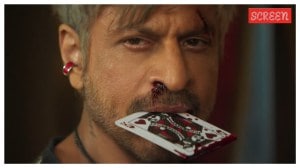Last walk for long marchers
Elections 2004 will mark a transition in more ways than one. This is likely to be the last time that an entire generation of leaders, leader...

Elections 2004 will mark a transition in more ways than one. This is likely to be the last time that an entire generation of leaders, leaders who have been part of the political matrix of India for decades, will play a critical role at the polls.
Both Atal Bihari Vajpayee and Lal Krishan Advani have steered the BJP since the fifties and sixties. Under them the party transitioned from its ‘‘untouchable’’ status to become the centrepiece of a coalition which is daring to package incumbency as a saleable commodity. Vajpayee, who is the man and the message of this election, is in his 80th year. And Advani, who is only three years younger and is undertaking an arduous rath yatra from Kanyakumari to Amritsar and Porbander to Puri, whizzing through 120 Lok Sabha constituencies in a month, may not be able to repeat the exercise five years hence. This may be Advani’s last chance to fight for the political space which his supporters feel rightfully belongs to him.
Though not formalised, the baton is already being passed to the next generation. Pramod Mahajan, Arun Jaitley, Venkaiah Naidu, Sushma Swaraj, Narendra Modi and many others are now actively taking the nitty gritty decisions — Mahajan overseeing election management, Jaitley doing media planning, all of them deciding on who should be inducted into the party. Of course, the top two are consulted about everything. But ‘‘D.P. Yadav’’ would not have happened had Vajpayee and Advani been engaged in day-to-day decision-making, though they were responsible for overturning the decision.
In the RSS, too, younger ideologues are coming to the fore, with Madandas Devi, S. Gurumurthy, Sanjay Joshi and Ram Madhav becoming more visible.
Take the Left parties. CPI(M) General Secretary Harkishen Singh Surjeet has formulated the party’s strategy in successive elections, fathered the third front, ironing out differences between mavericks, persuading, cajoling regional leaders, giving an ideological spin to Machiavellian politics. This time, he is lying low. So is Jyoti Basu. Nayanar too has had his day. Buddhadeb Bhattacharya is firmly in the saddle and Sitaram Yechury and Prakash Karat are the visible faces of the Politburo. On the parliamentary side, those like Nilotpal Basu have come into their own with their ability to competently articulate the issues of the day.
Several stalwarts in the states are getting ready to make way for their sons and daughters. M. Karunanidhi has already anointed M.K. Stalin as his successor and hopes to install him in the CM’s throne in 2006 — that is the reason he broke with the BJP and tied up with the Congress. This is probably the last time that Parkash Singh Badal or Bansi Lal will involve themselves in the rough and tumble of elections. Bal Thackeray has already appointed son Uddhav as his heir apparent.
Coming to the Congress, it is a much younger party under Sonia Gandhi. The old guard has been slowly fading away. K. Karunakaran has already piped down after being promised a Lok Sabha ticket for daughter Padmaja, a Kerala cabinet berth for son Murleedharan and a Rajya Sabha nomination for himself. P.V. Narasimha Rao, N.D. Tiwari and Pranab Mukherjee are not likely to get Lok Sabha nominations. (Though he is chief minister of Utaranchal, Tiwari was keen to contest for the Lok Sabha.) Arjun Singh is in the doghouse after son Ajay Singh went to call on BJP chief Venkaiah Naidu to discuss water harvesting. This is also probably the last election that the never say die Abdul Ghani Khan Chowdhury will contest.
One inadequately publicised but significant move made by the Congress is the launch of its “Young-25” for electioneering. This is a team of young leaders in their twenties and thirties who have fanned out to 45 cities, addressing youth audiences and press conferences under the Congress’s new initiative, ‘‘Disha 2004: Shiksha aur Rozgar’’. They include Jyotiraditya Scindia, Sachin Pilot, Randeep Surjewalla, C.R. Kesavan (Rajagopalachari’s great-grandson), Apok Jamir, Alka Lamba, Meenakshi Natarajan, Rajiv Gowda, Vivhakar Shastri (Lal Bahadur Shastri’s grandson).
More significant, and there have been enough signals to indicate this, is the likelihood of Priyanka and Rahul Gandhi taking the plunge. It is just a matter of when. If the Congress’s tally goes down, Priyanka’s entry may get expedited — if it improves, it may get delayed. But one thing is clear: given time, she may well take the Congress to victory. She has youth, charisma, the Gandhi-Nehru tag, and she reminds people of Indira Gandhi. People are looking for new faces, a break from the past and a strong leadership, and she could fit all those requirements.
Of course, except for the BJP, in most other parties the transition being made is from father to son or daughter, and at this rate Indian politics could be limited to 500 families before long. Be that as it may, the 2004 poll marks a youngward shift in politics in all parties.
- 01
- 02
- 03
- 04
- 05





























